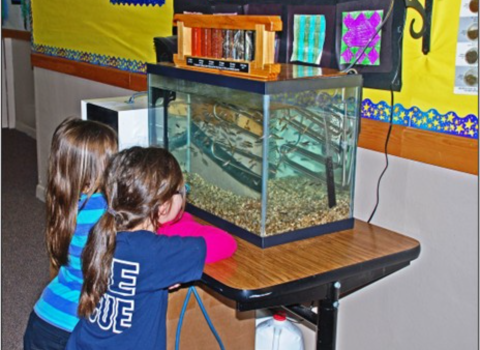After consulting with the telecommunications industry, academic researchers, other Federal and state agency representatives and bird conservation groups for more than a year, the U.S. Fish and Wildlife Service has published interim guidelines designed to reduce the number of birds killed in collisions with towers used to transmit wireless telephone conversations, television and radio broadcasts, and other signals.
The guidelines are interim measures representing the best scientific information presently available for reducing fatal bird collisions. These interim guidelines will be used by Service personnel in responding to requests for evaluations of new tower proposals, as the Service continues to work with industry to devise additional, more effective measures for avoiding bird strikes. The guidance they provide is voluntary and non-binding.
"These guidelines have been developed from research conducted in several eastern, southern, and midwestern states, and provide the best scientific knowledge available on designing and siting towers to reduce the danger they present to migrating birds. We look forward to working with industry to implement these guidelines while conducting further research to advance our knowledge of the problem and its solutions," said Service Director Jamie Rappaport Clark.
The guidelines include recommendations to co-locate proposed new antenna arrays on existing towers or other structures whenever possible; to build towers as short as possible and without guy wires or lighting; to site new towers in "antenna farms" away from wetlands or other known bird concentration areas; and to use white strobe lights, which appear to be less attractive to birds than pulsating lights, on towers that must be lighted for aviation safety.
The Service conservatively estimates that more than 4 million birds are currently being killed every year in North America in collisions with communications towers, though more research needs to be done to document the full extent of the problem and to explore additional ways to minimize deaths. Towers pose a special danger to some 350 species of night-migrating songbirds, especially on foggy nights. Under these conditions, birds are attracted to towers with pilot warning lights, which are required by the Federal Aviation Administration for towers taller than 200 feet, and for all towers within 3 miles of an airport.
Researchers have observed bird kills at communications towers for decades, with one Service estimate in 1979 placing the number killed at 1.3 million per year. That estimate was based on a survey of some 500 of the 1,010 tall towers then in existence. Today, there are more than 75,000 towers registered with the Federal Communications Commission, including nearly 45,000 towers greater than 200 feet in height. Industry projections indicate there may be as many as 100,000 new towers built in the next decade. Due to a Congressional mandate to digitize all television stations by 2003, an estimated 1,000 of these new towers will exceed 1,000 feet in height, creating a potentially serious threat to migrating birds.
Service field stations have been involved in evaluating tower effects on birds and identifying ways to minimize losses since 1996. The Division of Migratory Bird Management began to address the issue in 1998, when it helped develop a tower risk model that gave researchers a clearer picture of the factors that contribute to fatal bird collisions. In June 1999, the Communication Tower Working Group, chaired by the Service and including 42 industry, academic, private conservation and government stakeholders, was formed to develop, help fund, and implement a nationwide research protocol assessing causes of the collision problem and researching solutions.
In August 1999, the Service co-chaired a public workshop, "Avian Mortality at Communications Towers", at Cornell University, giving researchers and policy makers a forum to begin to assess and discuss the scope of the problem. This past summer, the Working Group reviewed and approved a nationwide research protocol that sets parameters and goals for future studies.
The wireless telephone industry has been supportive of efforts to examine the problem. Southwestern Bell Wireless is discussing funding pilot studies that could begin as early as this fall. The Cellular Telecommunications Industry Association has suggested that the Working Group submit a full research proposal for a 3-to-5-year nationwide monitoring effort to their Board of Directors for consideration.
"Were pleased that the wireless telecommunications industry has recognized the need to study this issue further, and is considering helping to fund the research efforts. Their support is vital as we begin the process of making migration safer for hundreds of species of migratory birds," said Service Director Clark.
The interim guidelines can be found on the Services internet site at http://migratorybirds.fws.gov/issues/towers/comtow.html . For more detailed information, contact the Division of Migratory Bird Management at (703) 358-1714.
The U.S. Fish and Wildlife Service is the principal Federal agency responsible for conserving, protecting and enhancing fish, wildlife and plants and their habitats for the continuing benefit of the American people. The Service manages the 93-million-acre National Wildlife Refuge System which encompasses more than 530 national wildlife refuges, thousands of small wetlands and other special management areas. It also operates 66 national fish hatcheries, 64 fishery resource offices and 78 ecological services field stations. The agency enforces Federal wildlife laws, administers the Endangered Species Act, manages migratory bird populations, restores nationally significant fisheries, conserves and restores wildlife habitat such as wetlands, and helps foreign governments with their conservation efforts. It also oversees the Federal Aid program that distributes hundreds of millions of dollars in excise taxes on fishing and hunting equipment to state fish and wildlife agencies.
- FWS -


